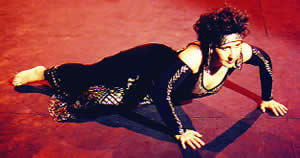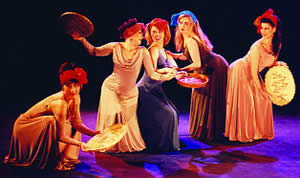Positive Health Online
Your Country

Therapeutic Value of Dance
by Wendy Buonaventura(more info)
listed in movement, originally published in issue 99 - May 2004
A recent British survey came up with the fascinating result that, next to eating out, what people of all ages enjoy doing most in their spare time is… no, not going to the cinema or sitting in front of the TV but… yes, dancing!
When I began teaching and performing Arabic – or Middle Eastern – dance many years ago, I was interested in it simply as an art form. I wasn't so concerned then with the social aspect of dancing, and it never occurred to me to look at its therapeutic qualities, although I soon became aware of its many beneficial aspects. One of my older students told me that the undulating spinal movements and torso work helped her get rid of years of back problems; others reported relief from all kinds of pelvic ailments, and one woman in her early fifties reported that the exercise was helping her combat hot flushes.

...tango is promoted as steamy and sexy,
flamenco as proud and fiery, Arabic as titillating.

Endurance or Enjoyment?
Awareness of growing obesity in all age groups has led to the government advocating exercise as the solution to our sedentary lives; but this advocacy has focused solely on gym and sporting activities. Listening the other day, at first in amusement, to a radio programme discussing how we simply don't have enough sports and gym facilities to fulfil the new government directive on exercise, I ended up yelling at the radio "What about dancing?" For not once was dance mentioned as an equally, if not more, valuable source of exercise than kicking a ball around or pumping iron. We may have enjoyed a social revolution in the 1960s, and a sexual revolution of a kind. But in terms of encouraging us to feel at ease with our bodies, there's a long way to go, and the media seems intent on turning the clock back to the days when guilt was the normal state of mind. It's a truism that we're bombarded with images of food from every side, yet encouraged to feel that eating is naughty. The guilt these mixed messages inspire has made a lot of diet gurus very wealthy. It's helped foster eating disorders and a neurotic dissatisfaction with the way we look which has led women rushing to cosmetic surgeons to have their faces and bodies rearranged. So here we are, being encouraged to eat healthily and keep fit, yet the message remains that we shouldn't really be enjoying ourselves in the process.
Why else would we now have a hugely popular gym culture based on the idea that keeping fit should involve absolutely no spirit of creativity or play? It seems to me that going to the gym is about endurance rather than pleasure. It's about pushing ourselves beyond our natural limits, and the huge popularity of gyms shows how many people have bought into this competitive, self-punishing culture.
True, gyms do offer dance classes. But am I the only person who thinks that the soulless music and mind-numbing routines of so many of these classes make them more like army exercises than anything else? They offer none of the skills traditionally conferred by dance, such as grace, self-expression and improved confidence in ourselves.
The Media
The media is partly to blame for its blinkered appraisal of what dancing has to offer us; in other words, its presentation of dance as largely a form of sexual expression. Every now and then an article appears in the press, telling us we're experiencing a resurgence of interest in dancing, with a particular style spearheading the fuss – in general, a high-energy youth style like disco or salsa. But there's nothing new in this. It's just that the searchlight of media interest has swept across a particular dance for a brief moment before moving on to the next body craze. Human beings have always danced socially, and during wars people danced as if driven. We've danced to let off steam, to express ourselves and get rid of excess energy, we've danced to attract a partner and for religious reasons.
But mostly, when dance gets a write-up in the press, the focus is on its most obvious commercial nature. So, tango is promoted as steamy and sexy, flamenco as proud and fiery, Arabic as titillating. Multi-cultural dance forms like these have attracted a huge following in recent years. But very few people who go along to a class – attracted by this initial stereotype – will persist unless they discover that dancing offers all kinds of other things besides pulling power.
Adopting a Dance Form
In my experience, people who take up a dance form often become, if not obsessed, then completely devoted to it. It isn't unusual for tango dancers to have their entire social life taken over by workshops and milongas (social dance evenings). Meanwhile, women (and it remains largely women who go to dance classes of whatever kind) who discover a passion for Arabic dance often become involved in learning about the culture, especially its cuisine, and may end up taking regular holidays in North Africa and Egypt. I've learnt many dance forms, but Arabic is the dance about which I'm best qualified to talk, as I've taught and performed it for many years.
And chief among its attractions is that, in order to look and feel good doing it you don't need to conform to the narrow body image, which dominates the Western ideal of attractiveness. One of the unusual qualities of Arabic dance is that it exercises the back and the entire torso. Most Western dance, including couple dancing, fails to touch the torso, which is left as an area of 'dead' or 'frozen' energy sandwiched between the arms and legs, which do most of the work. Arabic dance uses muscles in the back and chest and belly. It wakes up the energy here (as well as in the hips), and includes movements which are vigorous and, in turn, gentle and meditative as well.
But every dance offers us something different and equally valuable, especially in terms of body awareness. Flamenco is a proud dance which makes us especially aware of how we're holding our upper body; it makes us lift up and out of our chest; African dance gives the torso a high-energy workout and makes us sweat; couple dances – from ballroom and swing to samba and tango – teach us about relationship; we learn co-ordination and how to move in harmony with a partner and not just do our own thing. And then there's the music. Social dance forms develop hand in hand with their music; in a sense every dancer becomes another instrument in the band, reflecting and expressing the siren song, which calls the body into moving. Tango and swing are just two kinds of music which I've come to love through going to dance classes; a new world of sound has opened up for me, endless hours of listening pleasure.
A few years ago I gave up teaching in order to research and write a book about women, dance and sensuality*. At the time I needed a break from teaching; I felt that, if I had to teach one more woman how to do a shimmy or a hip swivel, I'd go stark staring mad! It didn't take me long, though, to start feeling stiff and physically ill at ease. Reluctant to start my classes again I tried being a punter for a change. I tried any number of other dances, as well as swimming, T'ai Chi and yoga. But in the end, nothing was as satisfying as the dance I'd spent twenty years perfecting and enjoying. Nothing gave me such a good workout, and in the end I decided to start a 'Dance For Women' class. Twenty years on, I find a different focus in teaching: with my own body changing, I'm more aware of how necessary it is to keep moving, to keep the body supple and in tune and, more than that: I understand what a very old flamenco dancer once said to me. "When you dance," she said, "there is no such thing as old age."
Comments:
-
No Article Comments available